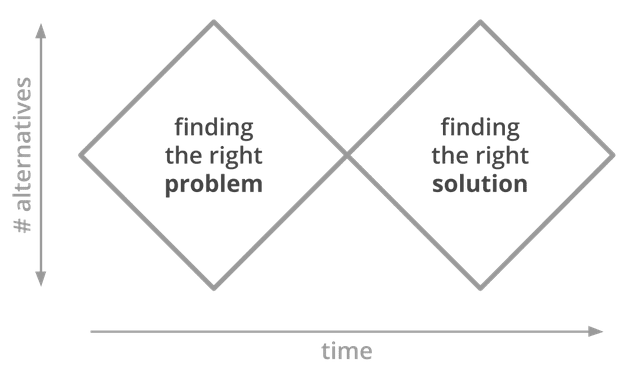
Beautiful and usable design can be the deciding factor between a successful and a failing business. Great designers are treated like superstars. And it’s so fulfilling to design beautiful things that people love to use. But can you become a designer at all without a degree in design? Will you have to go back to school to pursue the career of your dreams?
In my opinion, yes and no. Based on my own experience, I’m gonna share five pieces of advice that will bring you closer to becoming a designer, no matter what you’re doing right now.
It was during my Bachelor’s thesis that I first came into contact with user research; and after that, I fell in love with anything usability and UX design. Today, I’m a UX Manager and take care of a wide variety of design topics. But when you simply look at my diplomas, you wouldn’t expect any of that, since I hold a B.Sc. in computer science and two engineering degrees.
[Read: ]
But how did I do it? How did I start off as a computer science student thinking about a career in software engineering and end up teaching UX design to students at the University of Michigan? What would I tell someone who asks me: I have studied X, which has nothing to do with design, how do I become a designer?
1. Understand that the process is the design
The first step towards becoming a designer is to understand what design really is. Many people still mistake design for visual design. But design isn’t just Photoshop. It’s the entirety of the underlying process, including what the final outcome looks like.
According to Alan Cooper’s About Face, this includes designing behavior, form, and content. Also, it involves a considerable amount of user research because good design cannot happen without a deep understanding of your users.
Design is nothing one person simply makes up and that’s it. You’re always designing for someone by solving a problem together with other designers. I want to give you two quotes to underpin this.
The first one, from my own article “What is Design Thinking“:
“Design Thinking is the understanding that the process is the design and therefore all people involved, no matter their role, are responsible for creating a product that is useful, functional, aesthetically appealing, and affordable.”
And the second one, by Ana Kraš:
“Design is not decoration. Design is to make something work. Design is a thought process, the solving of a problem.”
2. Read Don Norman’s The Design of Everyday Things
Don Norman is a professor emeritus of cognitive science and headed Apple’s Advanced Technology Group. And he has written the book that tells you all you need to know about the theory of design: the psychological and cognitive backgrounds, how to tell good design from bad, why everything around you is (mostly bad) design, how humans form mental models, the basics of human-centered design, the double diamond model (see below), and much more.

3. Practice sketching and rapid prototyping (a lot)
While you don’t need Photoshop skills to become a designer, it’s inevitable to sketch a lot. Not only is it fun, but also makes it easier to reason your ideas, never forget an idea in the first place, and to get your creative juices flowing (cf. Boost your creativity with daily sketching).
Yet, this doesn’t mean your sketches have to look good, as long as they manage to get your idea across in terms of the structure of a product and the interactions you envision. Hence, buy a notebook and scribble as if there’s no tomorrow! Basically, a good UX design can be as little as sketches on a napkin.
As for rapid prototyping, I highly recommend paper prototypes. They’re easy to create, simulate interactivity, and deliver a ton of extremely helpful insights before writing actual code. For more on this, read Marc Rettig’s classic Prototyping for Tiny Fingers.
Moreover, you can create pretty elaborate prototypes using tools like InVision or Balsamiq. Since I have a technical background, I usually just prototype directly in HTML/CSS/JS.
Essentially, you have to play around with all the different possibilities and stick to those you feel most comfortable with. The important thing is: a prototype isn’t polished; it’s meant for collecting feedback quickly and iterating — hence, rapid prototyping.
4. Learn to conduct user research
A huge portion of design consists of user research, both for identifying problems and finding solutions. Hence, it’s indispensable to understand the necessity and value of good research and to be able to conduct proper research.
Depending on the stage of the design process, the methods you use can differ greatly. Early on, they tend to be more qualitative and attitudinal. For instance, you’d do some ethnographic field research to discover user’s pain points and everyday problems. Later, when research questions evolve more around, e.g., the usability of a product, methods become more quantitative and behavioral.
For a nice, comprehensive overview of user research methods, please refer to this article by Christian Rohrer.
Another source I’d recommend for learning about the immense value of user research is Robert Hoekman, Jr.’s Experience Required.
Additionally, there are a plethora of courses to get started with user research available on platforms like Coursera, e.g., one by the University of Michigan.
5. Double delivery
In 2018, I attended “A Conversation with David Kelley” at the University of Michigan. Kelley is one of the founders of IDEO and a professor at Stanford University. Similar to the topic of this article, someone from the audience asked something along the lines of: I work in a non-design job and therefore don’t get assigned any design tasks. How can I manage to be recognized more as a designer?
Kelley answered the following: do what you were asked to do, but do it using a design methodology. This is what he called double delivery.
This means, no matter what job you’re in right now, apply design methods as often as possible and whenever appropriate. You don’t need a so-called “design task” to do design. Sketch, prototype, conduct user research, or employ one of the methods from 5 design methods I’ve successfully applied as a UX Manager at C&A.
A good go-to source for all kinds of methods that I use on a regular basis is IBM’s Enterprise Design Thinking Toolkit.
Conclusion
Becoming a designer can seem like a nearly impossible endeavor if you’ve never formally done anything with design. However, it is possible, regardless of your formal education, even though it will surely take time and effort.
Essentially, anyone who makes something that is used by other people, be it a chair, a mobile app, or a business process, already does design — whether they’re aware of it or not. However, being a designer takes a little more than that.
If you understand what design really is, learn to sketch and prototype, learn to conduct quality user research, and engage in double delivery whenever possible, all doors will be open to you.
So you’re interested in design? Then join our online event, TNW2020, to explore how technology is changing how we create, experience, and share art.
Get the TNW newsletter
Get the most important tech news in your inbox each week.




